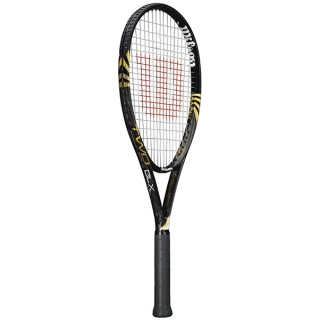Tennis Racquet Review: Wilson Two BLX
March 6th, 2013
The Wilson BLX Two is the latest update to their long-time ‘hammer’ series of tennis racquets. Generally regarded as a game-improvement design, the hammer racquets have traditionally been used by a wide-variety of players and skill levels.
APPEARANCE / STYLE
I immediately noticed that the Wilson BLX Two has a subtle design—not “loud” or “in-your-face” at all. It is an attractive natural look and one can see through the clear-coat and observe the weave of the frame material. It is accented with golden stripes, decals, and white paint at the throat.
TECHNOLOGY
The Wilson BLX Two features 2 of Wilson’s tech features:
1) Basalt (BLX): Basalt fibers are woven into the frame to reduced unwanted frequencies (vibrations) and to provide better feedback and feel;
2) Hammer: maintains the majority of racquet mass (weight) in the frame’s head (head-heavy balance) to increase power and stability. Weight is also reduced in the handle and shaft which creates a larger and higher “sweetspot”.
SPECIFICATIONS
The BLX Two has a 110” head and weighs 8.4 oz. unstrung. It has a string pattern of 16 mains and 20 crosses. It is 15 pts. head-heavy (like a hammer!) It has a variable width beam (cross-section) which measures 25mm/26.5mm/26mm wide. It is rated by Wilson as appropriate for players with a medium to long stroke—but a slower swing speed. It is an extended-reach racquet measuring @ 27.25” in length. It is designed to be on the higher-end of the stiffness scale.
GROUNDSTROKES
The Wilson BLX Two added depth and some power to my shots. I normally play with a thin-beam flexible racquet and noted that I could perform baseline rallies with a slower, easier swing. The racquets relatively open “fan” pattern seemed to add a little more bite on the ball and produced some good spin. It’s obvious—very obvious—head-heavy balance prevented me from using my normal full-swing “wind-up”. I just could not get the racquet around quick enough with the wind-up. Players with a straight take-back swing preparation should do well with this racquet. The larger head size and high racquet stiffness really helps prevent the racquet from twisting on off-center hits (huge sweetspot!).
VOLLEYS
This racquet was very accurate at the net. It felt very stable and solid. Its extended length and larger head helped close-the-gap when poaching. It was slightly less quick at the net due to head-heavy balance—but the power it delivered more than compensated for this trait.
OVERHEADS
Overheads / smashes were good. The power this racquet delivers on a “sitting duck” is incredible!
SERVES
Serves were also excellent with the Wilson BLX Two. I was concerned that it would deliver good power (it did) but at the expense of accuracy. I learned that placement was not an issue—perhaps due to the larger sweetspot.
SPIN POTENTIAL
Wilson has long utilized a “fan” pattern on many of its racquets (primarily game-improvement designs). BLX Two has such a pattern, and this is coupled with the fact there are only 16 main strings on this 110” racquet. These strings really have the opportunity to “bite” the ball. I was completely satisfied with the amount of spin produced.
CONCLUSION
The Wilson BLX Two is a well-designed and appropriate racquet for a variety of players: those seeking more power from their racquet; those who have compact or medium swings at slower speed; and those who wish for a little more “margin of error” when hitting. If you have been using head-light racquets for years, but can no longer get the depth of shots like you used to, this may be a good choice.
Greg Christopherson
Oceanside, CA



